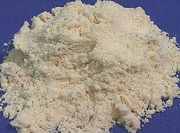Previous Page | Right click this page to print.
Protein Supplements of Animal Origin - Milk-Based Products
Milk-based products originate from milk and milk processing operations. The nutritional value of milk products is described as superior. Milk products are a good source of protein, essential amino acids, minerals, vitamins, and contain lactose. Milk-based products are low in fiber. Milk-based products are low in vitamin D and iron. Milk-based products are also palatable and digestible. Milk-based products are marketed as liquid, semisolid, and dried products with a dry-matter content of 10, 30, and 90%, respectively. The primary factor limiting the use of milk products as animal feedstuffs is cost.
Dried, whole milk is an excellent feedstuff, especially for young mammals.
Figure 7.4 illustrates dried milk.

For dried, whole milk, the minimum milk-fat content is 26% and the maximum water content is 8%. The average crude protein content of dried, whole milk is 25% on an as-fed basis. Due to cost, use of whole milk in animal rations is limited. Skimmed milk is another high-quality milk-based feedstuff. Skimmed milk is available as liquid, condensed, and dried. In comparison to whole milk, skimmed milk is higher in protein, sugar, and mineral contents and lower in vitamin A content. The average crude protein content of liquid skimmed milk on an as-fed basis is 3%. Condensed and dried skimmed milk are required to maintain minimum solids contents of 27% and 92%, respectively. Skimmed milk products may be fed to monogastrics and ruminants. The feeding value will vary with animal age, ration type, price of feeds, and amount to be fed.
Buttermilk is another milk-based feedstuff. Buttermilk is available as liquid, condensed, and dried. The nutritional value of liquid buttermilk is similar to the value of respective skimmed milk. Buttermilk does have a higher energy content compared to skimmed milk. Condensed buttermilk is produced by evaporating buttermilk to one third of the original weight. The minimum solids content is 27%. The crude protein content of condensed buttermilk is 11% on an as-fed basis. One pound of condensed buttermilk is equal to three pounds liquid buttermilk. The maximum water content of dried buttermilk is 8%. The crude protein content of dried buttermilk is 32% on an as-fed basis. One pound of dried buttermilk is equal to ten pounds liquid buttermilk.
Cheese rind or cooked cheese trimmings are cheese trimmings having most of the fat removed. It is reported cheese rind has a good nutritional value. The crude protein content is approximately 50% and the fat content is approximately 20%, both on an as-fed basis.
Other milk-based products include casein, dried hydrolyzed casein, dried milk albumin, dried milk protein, and dried whey protein concentrate. Cost of these restricts the use of these products as animal feeds.
Previous Page | Right click this page to print.